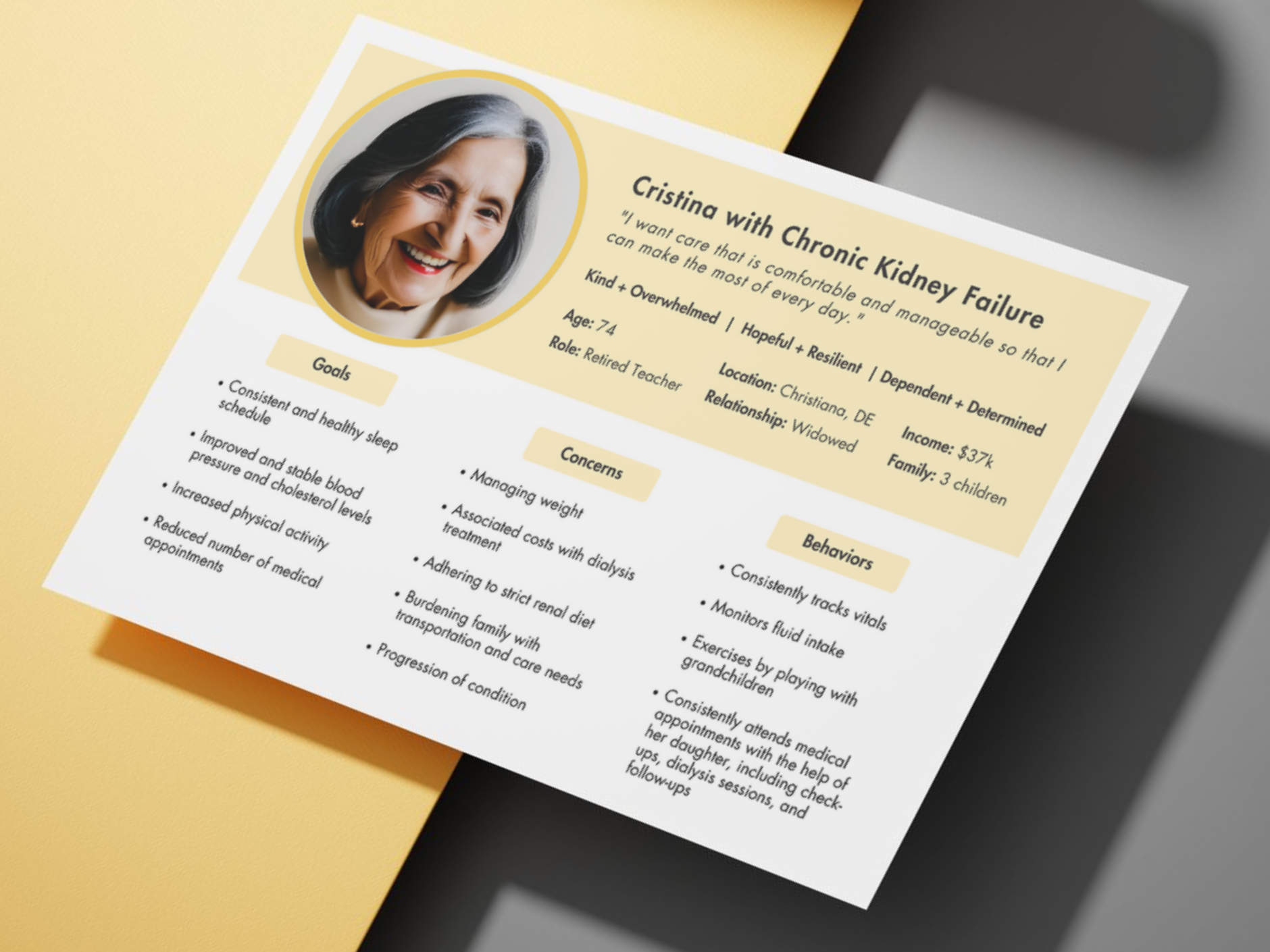
Researching Robotics for In-Home Care
UX Research | Inclusive Design | Health Tech | AI & Robotics
Conducting qualitative and quantitative research on how in-home robots could support patients and reduce re-hospitalization.
Overview
The goal of this project is to reduce the number of hospital readmissions by bridging the gap between appointments and home health visits with 24/7 personalized support.
I contributed to this project by analyzing patient data to create personas, user journey maps, and empathy maps.
These artifacts will be used to assist the HTIC team in understanding and empathizing with our users, as well as finding ways to create added value by addressing user pain points.
Role
User Experience Design Intern | Researcher | Designer | Team of 4
Client
Health and Technology Innovation Center (HTIC) at ChristianaCare
Why are we introducing robotics into home health care?
Transitioning to Home Care
Patients who were recently hospitalized due to surgery or intensive care have to make a stressful transition back to their home environment with limited physical capabilities.
Risk of Relapse and Readmission
After leaving the hospital to recover at home, patients are at risk of relapse and infection, and this can lead to readmission to inpatient hospital facilities and longer recovery times.
Increased Support System
Patients deal with issues including pain, stress, and worry, so they need increased support during their recovery. However, the level of support actually available depends on their personal situation.
Emotional and Physical Comfort
During recovery, patients go through emotional stress and physical discomfort. Things like following a new routine can alleviate physical pain but increase mental burden.
How did I tackle this problem?
I worked with the HTIC UX team, HomeHealth staff, in-house developers, and patient participants to test a series of solutions.
I contributed by analyzing available patient data, regional data, and national data regarding home health statistics for our five focus areas, which are the highest areas of care for our home health system.
Working in a scrum cycle, the product owner tasked my team with deepening our understanding of the target users so that we can meet their needs in the product, in the installation, and in the product support.
5 Focus Areas
01.
Asthma
02.
COPD
03.
Chronic Kidney Failure
04.
Congestive Heart Failure
05.
Lung Cancer
Guiding Question
How can we better understand our target users so that we can meet their needs - both in the product itself and in product support after installation?
I wanted to make sure that our proposed added value aligned with the true user needs, so I took charge of turning data into insights, creating a set of research deliverables to be used throughout the robot's development.
*Please note that the following UX artifacts and insights are based on openly available data (national and local datasets), not data sourced from ChristianaCare due to HIPAA and NDA compliance. A couple of data-specific insights from this project cannot be shared here, but I replicated the process with open data as closely as possible.*
How did I get to know our users?
My first step was identifying who our users truly are, beyond their diagnosis. My main goal in data analysis and communication was to ensure that everyone on the project had a shared understanding of who we were creating this product for. I analyzed data from ChristianaCare's HomeHealth program, local Delaware public health datasets, and national reports from the CDC and the U.S. Census. I found that our users had distinct variations from national data with regards to gender, race, and marriage status, which informed a set of 5 personas for each of our focus areas.
To ensure that I had both qualitative and quantitative data for more robust findings, I interviewed a HomeHealth team member to gather insights that couldn't be found in numbers, such as their behaviors and goals.
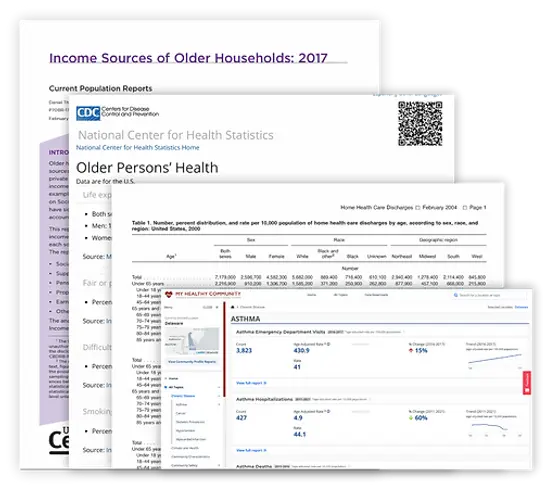
How did I identify and prioritize user needs?
In order to fully understand the needs of our users, I built on my research by creating personas, empathy maps, and journey maps for each of the five personas. This allowed me to create key insights on user needs that informed suggested solutions.
Personas (2 of 5)
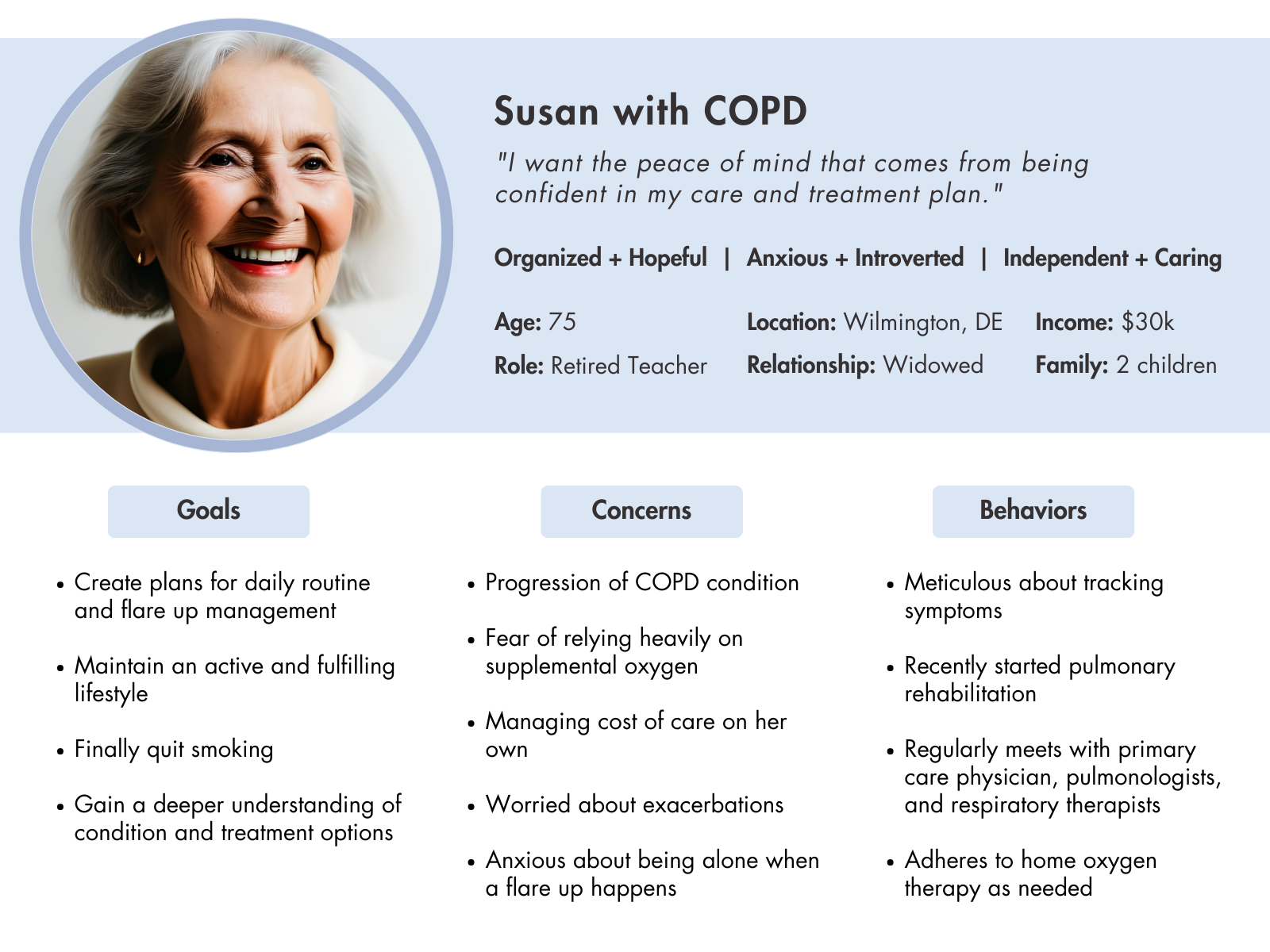
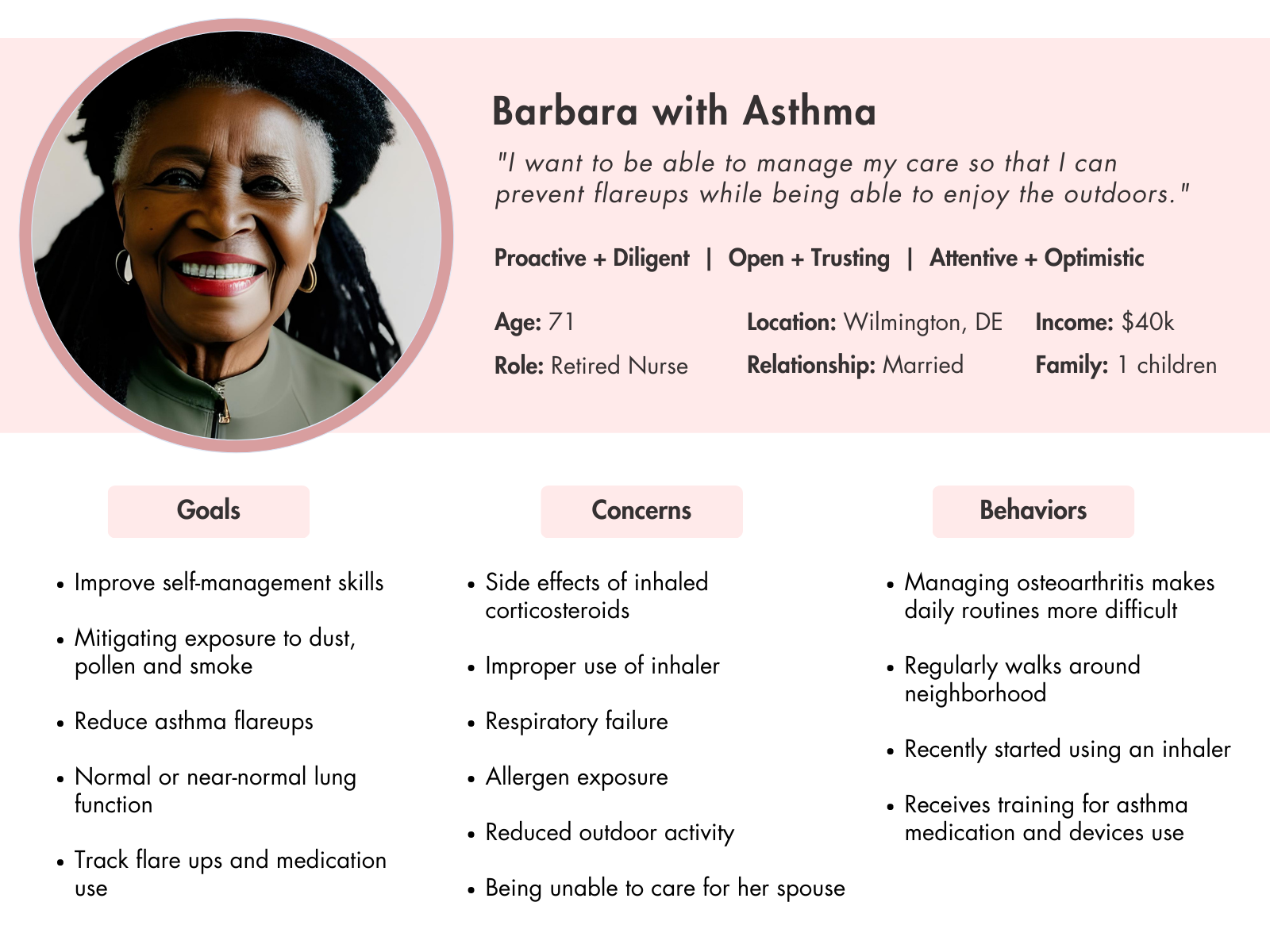
Empathy Map (1 of 5)
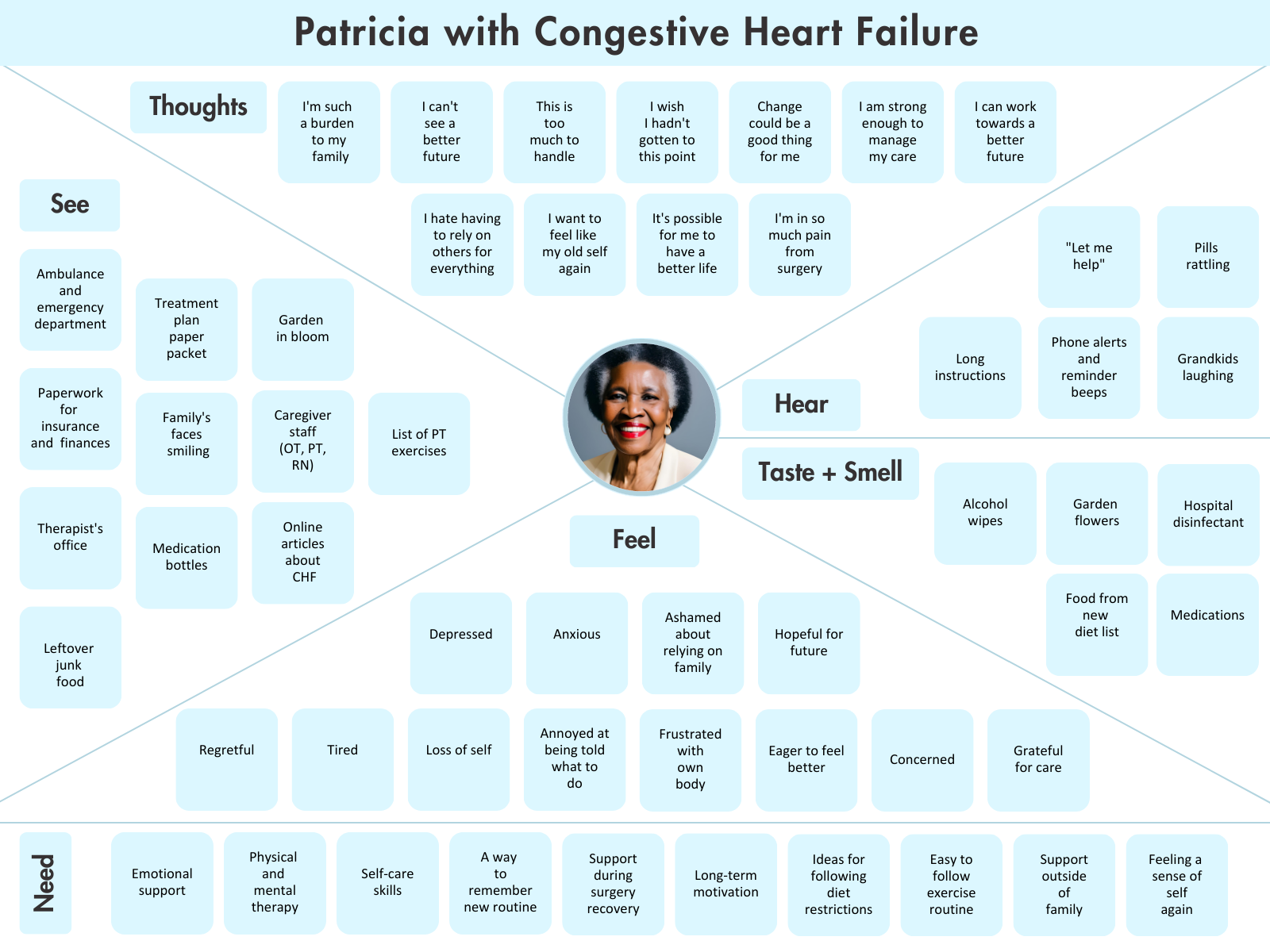
User Journey Map (1 of 5)
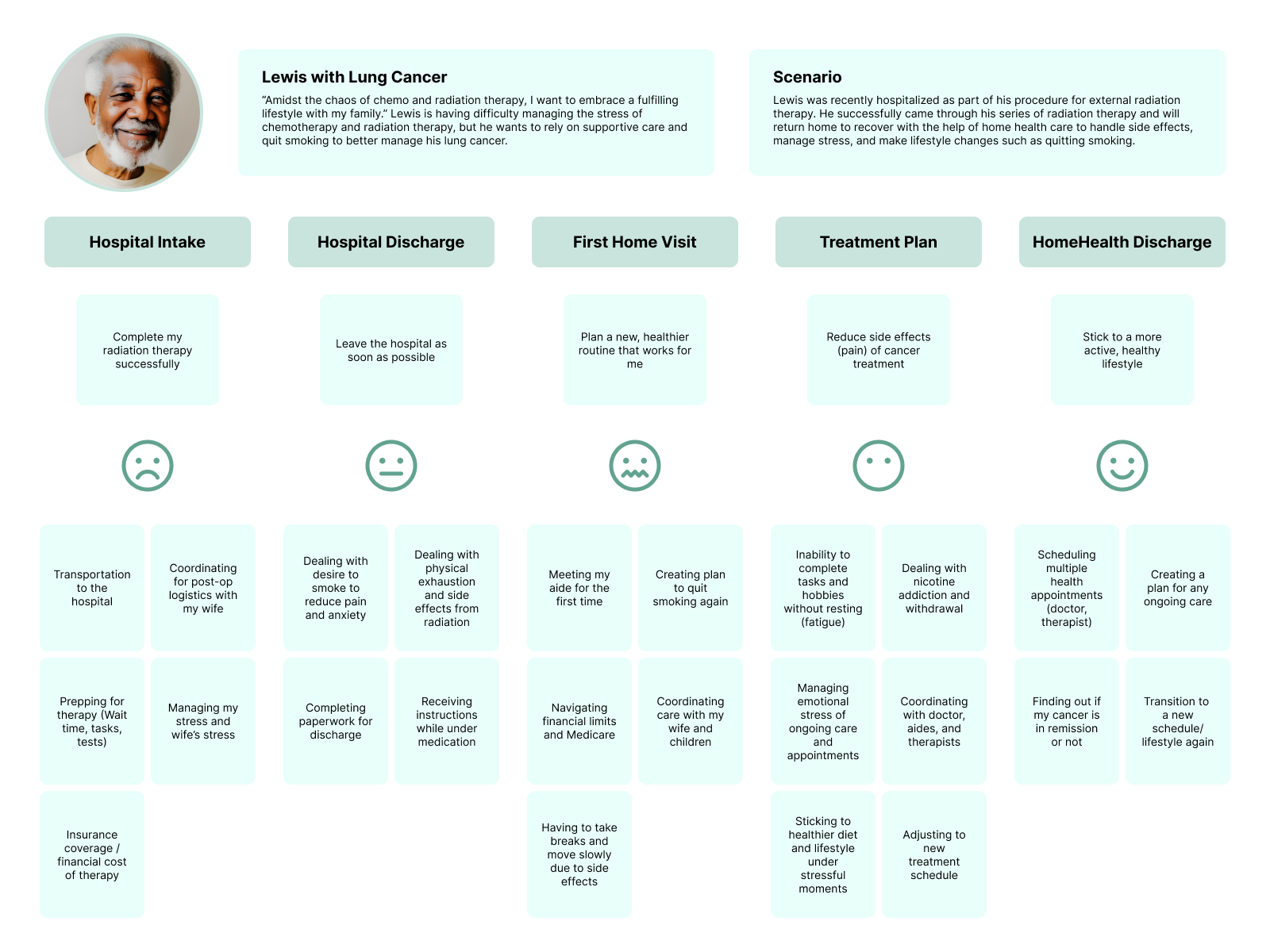
How did I turn insights into solutions?
I wrapped up my research by tying my insights to suggestions for improved design and added product value. See the sections below for how I addressed each user need with an actionable next step.
Need for different ways to interact based on ability
Provide multimodal options for input and output
Need for patients to develop an affinity for the robot
Anthropomorphized design with friendly features
Need for support in transitioning to a new routine
Provide daily reminders and medication storage
Need for more info about diagnosis, care, and treatments
Utilize AI to provide informal answers and resources to FAQ's
Need for robot to move easily through the patient's home
Build for sensor-based semi-autonomous movement
Need to avoid added burden on healthcare staff
Utilize older adults' mental models for intuitiveness
Need for connection with family and community
Provide ability to call, text, and video-call loved ones
Need for usability with changing ability levels during recovery
Provide customizable settings and follow WCAG guidelines
How did I relate our personas to product value for our stakeholders?
I had the opportunity to communicate with a variety of stakeholders during this process, and it was vital to be able to show how our product adds value in meeting these user needs. I tied each persona to an area of added value to maintain the level of understanding and empathy that I'd built thus far.
I focused on communicating my work in a way that allowed the stakeholders to understand both the current points of friction in our users' lives and how our product alleviates those points of friction.

24/7 Support
Susan helped us to understand how patients with COPD can benefit from the smart robot's capabilities, particularly smart reminders.
Smoking cessation and maintaining a healthy lifestyle can be difficult for an older adult living alone, but a smart robot can be a source of 24/7 support.
This support can help through providing suggestions for coping skills in smoking cessation, reducing mental loads, and providing positive reinforcement for successful routine adherence

Routine & Time
Lewis illustrates how important it is to our users to maintain a high quality of life, even with a diagnosis that can drastically shorten life expectancy.
When creating Lewis's collection, I found that there were opportunities for a daily routine support system.
If we could ease Lewis's daily routines with a smart robot, then he would be able to focus on his goals of spending more time with family.

Lifestyle Changes
Patricia showed a need for support in making big lifestyle changes, particularly in following a healthier diet and creating a regular exercise routine.
According to the CDC's data, women who receive home health services are more likely to be widowed than married.
Considering this population of elderly women living alone, a smart robot product could add immense value by integrating elements such as: conversational AI format, multimodal input (speech), and personalized recommendations.

Current Updates
Barbara helped our team hone in on the large population of women in the home health service program.
Focusing on asthma also allowed us to address current events affecting users' health, such as unprecedented smoke lingering in the air in major US cities.
Looking at the need for support with this ever-changing environment, we saw this as an opportunity to ensure the smart robot can help our patients with up-to-date information and accurate answers to both general and medical questions.

Balancing Stress
Cristina represents a patient population who needs a high level of support as they go through the difficult, time-consuming process of dialysis.
Cristina helps our team understand how the user journey affects not only the patient but also the patient's family members and informal support systems.
When we look at the need for informal support, we can see an opportunity to alleviate the stress on the patient and family members by creating an automated, smart solution in a friendly robot package.
Takeaways
I had the opportunity to complete this project in a Scrum/Agile method with a cross-functional team. Being able to work with developers, medical/nursing students, and other UX professionals helped me build a more focused collection of deliverables that directly addressed the user needs and stakeholder needs.
I also had the chance to explore several datasets to figure out exactly how our ChristianaCare Home Health users compared and contrasted with national averages. Being able to hone in on a specific set of diagnoses within one field of care was an enlightening exercise in confronting my assumptions that our data will match national data. Although I am not able to detail the experience here further, I will use this experience of addressing one's positionality and research assumptions as a valuable lesson in my future projects.
Researching Robotics for In-Home Care
UX Research | Inclusive Design | Health Tech | AI & Robotics
Conducting qualitative and quantitative research on how in-home robots could support patients and reduce re-hospitalization.

Overview
The goal of this project is to reduce the number of hospital readmissions by bridging the gap between appointments and home health visits with 24/7 personalized support.
I contributed to this project by analyzing patient data to create personas, user journey maps, and empathy maps.
These artifacts will be used to assist the HTIC team in understanding and empathizing with our users, as well as finding ways to create added value by addressing user pain points.
Role
User Experience Design Intern | Researcher | Designer | Team of 4
Client
AMSC Program Graduate Coordinator
Department of Mathematics
University of Maryland
Why are we introducing robotics into home health care?
Transitioning to Home Care
Patients who were recently hospitalized due to surgery or intensive care have to make a stressful transition back to their home environment with limited physical capabilities.
Risk of Relapse and Readmission
After leaving the hospital to recover at home, patients are at risk of relapse and infection, and this can lead to readmission to inpatient hospital facilities and longer recovery times.
Increased Support System
Patients deal with issues including pain, stress, and worry, so they need increased support during their recovery. However, the level of support actually available depends on their personal situation.
Emotional and Physical Comfort
During recovery, patients go through emotional stress and physical discomfort. Things like following a new routine can alleviate physical pain but increase mental burden.
How did I tackle this problem?
I worked with the HTIC UX team, HomeHealth staff, in-house developers, and patient participants to test a series of solutions.
I contributed by analyzing available patient data, regional data, and national data regarding home health statistics for our five focus areas, which are the highest areas of care for our home health system.
Working in a scrum cycle, the product owner tasked my team with deepening our understanding of the target users so that we can meet their needs in the product, in the installation, and in the product support.
5 Focus Areas
01.
Asthma
02.
COPD
03.
Chronic Kidney Failure
04.
Congestive Heart Failure
05.
Lung Cancer
Guiding Question
How can we better understand our target users so that we can meet their needs - both in the product itself and in product support after installation?
I wanted to make sure that our proposed added value aligned with the true user needs, so I took charge of turning data into insights, creating a set of research deliverables to be used throughout the robot's development.
*Please note that the following UX artifacts and insights are based on openly available data (national and local datasets), not data sourced from ChristianaCare due to HIPAA and NDA compliance. A couple of data-specific insights from this project cannot be shared here, but I replicated the process with open data as closely as possible.*
How did I get to know our users?
My first step was identifying who our users truly are, beyond their diagnosis. My main goal in data analysis and communication was to ensure that everyone on the project had a shared understanding of who we were creating this product for. I analyzed data from ChristianaCare's HomeHealth program, local Delaware public health datasets, and national reports from the CDC and the U.S. Census. I found that our users had distinct variations from national data with regards to gender, race, and marriage status, which informed a set of 5 personas for each of our focus areas.
To ensure that I had both qualitative and quantitative data for more robust findings, I interviewed a HomeHealth team member to gather insights that couldn't be found in numbers, such as their behaviors and goals.

How did I identify and prioritize user needs?
In order to fully understand the needs of our users, I built on my research by creating personas, empathy maps, and journey maps for each of the five personas. This allowed me to create key insights on user needs that informed suggested solutions.
Personas (2 of 5)


Empathy Map (1 of 5)

Journey Map (1 of 5)

How did I turn insights into solutions?
I wrapped up my research by tying my insights to suggestions for improved design and added product value. See the sections below for how I addressed each user need with an actionable next step.
Need for different ways to interact based on ability
Provide multimodal options for input and output
Need for patients to develop an affinity for the robot
Anthropomorphized design with friendly features
Need for support in transitioning to a new routine
Provide daily reminders and medication storage
Need for more info about diagnosis, care, and treatments
Utilize AI to provide informal answers and resources to FAQ's
Need for robot to move easily through the patient's home
Build for sensor-based semi-autonomous movement
Need to avoid added burden on healthcare staff
Utilize older adults' mental models for intuitiveness
Need for connection with family and community
Provide ability to call, text, and video-call loved ones
Need for usability with changing ability levels during recovery
Provide customizable settings and follow WCAG guidelines
How did I relate our personas to product value for our stakeholders?
I had the opportunity to communicate with a variety of stakeholders during this process, and it was vital to be able to show how our product adds value in meeting these user needs. I tied each persona to an area of added value to maintain the level of understanding and empathy that I'd built thus far.
I focused on communicating my work in a way that allowed the stakeholders to understand both the current points of friction in our users' lives and how our product alleviates those points of friction.

24/7 Support
Susan helped us to understand how patients with COPD can benefit from the smart robot's capabilities, particularly smart reminders.
Smoking cessation and maintaining a healthy lifestyle can be difficult for an older adult living alone, but a smart robot can be a source of 24/7 support.
This support can help through providing suggestions for coping skills in smoking cessation, reducing mental loads, and providing positive reinforcement for successful routine adherence

Routine & Time
Lewis illustrates how important it is to our users to maintain a high quality of life, even with a diagnosis that can drastically shorten life expectancy.
When creating Lewis's collection, I found that there were opportunities for a daily routine support system.
If we could ease Lewis's daily routines with a smart robot, then he would be able to focus on his goals of spending more time with family.

Current Updates
Barbara helped our team hone in on the large population of women in the home health service program.
Focusing on asthma also allowed us to address current events affecting users' health, such as unprecedented smoke lingering in the air in major US cities.
Looking at the need for support with this ever-changing environment, we saw this as an opportunity to ensure the smart robot can help our patients with up-to-date information and accurate answers to both general and medical questions.

Balancing Stress
Cristina represents a patient population who needs a high level of support as they go through the difficult, time-consuming process of dialysis.
Cristina helps our team understand how the user journey affects not only the patient but also the patient's family members and informal support systems.
When we look at the need for informal support, we can see an opportunity to alleviate the stress on the patient and family members by creating an automated, smart solution in a friendly robot package.

Lifestyle Changes
Patricia showed a need for support in making big lifestyle changes, particularly in following a healthier diet and creating a regular exercise routine.
According to the CDC's data, women who receive home health services are more likely to be widowed than married.
Considering this population of elderly women living alone, a smart robot product could add immense value by integrating elements such as: conversational AI format, multimodal input (speech), and personalized recommendations.
Takeaways
I had the opportunity to complete this project in a Scrum/Agile method with a cross-functional team. Being able to work with developers, medical/nursing students, and other UX professionals helped me build a more focused collection of deliverables that directly addressed the user needs and stakeholder needs.
I also had the chance to explore several datasets to figure out exactly how our ChristianaCare Home Health users compared and contrasted with national averages. Being able to hone in on a specific set of diagnoses within one field of care was an enlightening exercise in confronting my assumptions that our data will match national data. Although I am not able to detail the experience here further, I will use this experience of addressing one's positionality and research assumptions as a valuable lesson in my future projects.
Researching Robotics for In-Home Care
UX Research | Inclusive Design | Health Tech | AI & Robotics
Conducting qualitative and quantitative research on how in-home robots could support patients and reduce re-hospitalization.

Overview
The goal of this project is to reduce the number of hospital readmissions by bridging the gap between appointments and home health visits with 24/7 personalized support.
I contributed to this project by analyzing patient data to create personas, user journey maps, and empathy maps.
These artifacts will be used to assist the HTIC team in understanding and empathizing with our users, as well as finding ways to create added value by addressing user pain points.
Role
User Experience Design Intern | Researcher | Designer | Team of 4
Client
Health and Technology Innovation Center (HTIC) at ChristianaCare
Why are we introducing robotics into home health care?
Transitioning to Home Care
Patients who were recently hospitalized due to surgery or intensive care have to make a stressful transition back to their home environment with limited physical capabilities.
Risk of Relapse and Readmission
After leaving the hospital to recover at home, patients are at risk of relapse and infection, and this can lead to readmission to inpatient hospital facilities and longer recovery times.
Increased Support System
Patients deal with issues including pain, stress, and worry, so they need increased support during their recovery. However, the level of support actually available depends on their personal situation.
Emotional and Physical Comfort
During recovery, patients go through emotional stress and physical discomfort. Things like following a new routine can alleviate physical pain but increase mental burden.
How did I tackle this problem?
I worked with the HTIC UX team, HomeHealth staff, in-house developers, and patient participants to test a series of solutions.
I contributed by analyzing available patient data, regional data, and national data regarding home health statistics for our five focus areas, which are the highest areas of care for our home health system.
Working in a scrum cycle, the product owner tasked my team with deepening our understanding of the target users so that we can meet their needs in the product, in the installation, and in the product support.
5 Focus Areas
01.
Asthma
02.
COPD
03.
Chronic Kidney Failure
04.
Congestive Heart Failure
05.
Lung Cancer
Guiding Question
How can we better understand our target users so that we can meet their needs - both in the product itself and in product support after installation?
I wanted to make sure that our proposed added value aligned with the true user needs, so I took charge of turning data into insights, creating a set of research deliverables to be used throughout the robot's development.
*Please note that the following UX artifacts and insights are based on openly available data (national and local datasets), not data sourced from ChristianaCare due to HIPAA and NDA compliance. A couple of data-specific insights from this project cannot be shared here, but I replicated the process with open data as closely as possible.*
How did I get to know our users?
My first step was identifying who our users truly are, beyond their diagnosis. My main goal in data analysis and communication was to ensure that everyone on the project had a shared understanding of who we were creating this product for. I analyzed data from ChristianaCare's HomeHealth program, local Delaware public health datasets, and national reports from the CDC and the U.S. Census. I found that our users had distinct variations from national data with regards to gender, race, and marriage status, which informed a set of 5 personas for each of our focus areas.
To ensure that I had both qualitative and quantitative data for more robust findings, I interviewed a HomeHealth team member to gather insights that couldn't be found in numbers, such as their behaviors and goals.

How did I identify and prioritize user needs?
In order to fully understand the needs of our users, I built on my research by creating personas, empathy maps, and journey maps for each of the five personas. This allowed me to create key insights on user needs that informed suggested solutions.
Personas (2 of 5)


Empathy Map (1 of 5)

User Journey Map (1 of 5)

How did I turn insights into solutions?
I wrapped up my research by tying my insights to suggestions for improved design and added product value. See the sections below for how I addressed each user need with an actionable next step.
Need for different ways to interact based on ability
Provide multimodal options for input and output
Need for patients to develop an affinity for the robot
Anthropomorphized design with friendly features
Need for support in transitioning to a new routine
Provide daily reminders and medication storage
Need for more info about diagnosis, care, and treatments
Utilize AI to provide informal answers and resources to FAQ's
Need for robot to move easily through the patient's home
Build for sensor-based semi-autonomous movement
Need to avoid added burden on healthcare staff
Utilize older adults' mental models for intuitiveness
Need for connection with family and community
Provide ability to call, text, and video-call loved ones
Need for usability with changing ability levels during recovery
Provide customizable settings and follow WCAG guidelines
How did I relate our personas to product value for our stakeholders?
I had the opportunity to communicate with a variety of stakeholders during this process, and it was vital to be able to show how our product adds value in meeting these user needs. I tied each persona to an area of added value to maintain the level of understanding and empathy that I'd built thus far.
I focused on communicating my work in a way that allowed the stakeholders to understand both the current points of friction in our users' lives and how our product alleviates those points of friction.

24/7 Support
Susan helped us to understand how patients with COPD can benefit from the smart robot's capabilities, particularly smart reminders.
Smoking cessation and maintaining a healthy lifestyle can be difficult for an older adult living alone, but a smart robot can be a source of 24/7 support.
This support can help through providing suggestions for coping skills in smoking cessation, reducing mental loads, and providing positive reinforcement for successful routine adherence

Routine & Time
Lewis illustrates how important it is to our users to maintain a high quality of life, even with a diagnosis that can drastically shorten life expectancy.
When creating Lewis's collection, I found that there were opportunities for a daily routine support system.
If we could ease Lewis's daily routines with a smart robot, then he would be able to focus on his goals of spending more time with family.

Lifestyle Changes
Patricia showed a need for support in making big lifestyle changes, particularly in following a healthier diet and creating a regular exercise routine.
According to the CDC's data, women who receive home health services are more likely to be widowed than married.
Considering this population of elderly women living alone, a smart robot product could add immense value by integrating elements such as: conversational AI format, multimodal input (speech), and personalized recommendations.

Current Updates
Barbara helped our team hone in on the large population of women in the home health service program.
Focusing on asthma also allowed us to address current events affecting users' health, such as unprecedented smoke lingering in the air in major US cities.
Looking at the need for support with this ever-changing environment, we saw this as an opportunity to ensure the smart robot can help our patients with up-to-date information and accurate answers to both general and medical questions.

Balancing Stress
Cristina represents a patient population who needs a high level of support as they go through the difficult, time-consuming process of dialysis.
Cristina helps our team understand how the user journey affects not only the patient but also the patient's family members and informal support systems.
When we look at the need for informal support, we can see an opportunity to alleviate the stress on the patient and family members by creating an automated, smart solution in a friendly robot package.
Takeaways
I had the opportunity to complete this project in a Scrum/Agile method with a cross-functional team. Being able to work with developers, medical/nursing students, and other UX professionals helped me build a more focused collection of deliverables that directly addressed the user needs and stakeholder needs.
I also had the chance to explore several datasets to figure out exactly how our ChristianaCare Home Health users compared and contrasted with national averages. Being able to hone in on a specific set of diagnoses within one field of care was an enlightening exercise in confronting my assumptions that our data will match national data. Although I am not able to detail the experience here further, I will use this experience of addressing one's positionality and research assumptions as a valuable lesson in my future projects.
